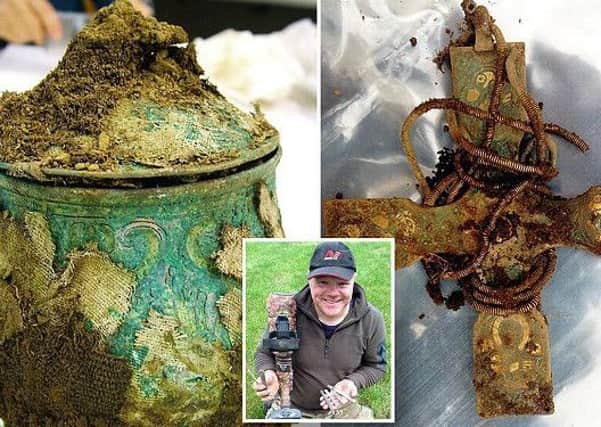A Viking treasure that everyone wants to own


But while coach parties and school trips flock to the Chamber Street museum’s exhibition from now until October (it will be a star attraction for foreign visitors this summer too) there’s been a genteel and occasionally colourful rammy over who gets to keep the collection.
Galloway stalwarts dressed as Vikings descended on the capital to demand the return of the loot on a permanent basis.
Advertisement
Hide AdAdvertisement
Hide AdIt is a saga familiar to anyone who recalls the arguments over where the famous Lewis chess set should be displayed, with local enthusiasts there arguing that the iconic walrus ivory pieces should remain in the Outer Hebrides.


In that case a sort of compromise deal was struck, with six of the chessmen now displayed permanently in a special museum on Lewis, while the bulk of the find remains in London’s British Museum.
If the entire Galloway Hoard were to be permanently housed in Dumfries and Galloway (possibly in a custom-built, showpiece museum), visitor tourism would surely go through the roof.
In fact National Museums, well aware of the nature of the arguments, has also come up with what could be a workable solution - one in which it would control the detailed restoration and interpretation work while regularly loaning out the whole collection to Kirkcudbright.
Advertisement
Hide AdAdvertisement
Hide AdSome will consider the offer generous and practical - others will still hanker after outright ownership by Dumfries and Galloway.


The big winner in this case is of course Mr Derek McLennan, whose nifty use of a metal detector will net him a few bob short of two million pounds.
But as a further complication the National Museum, understandably eager not to be parted from such a spectacular asset, has to find that money by November 12 or wave its amazing windfall a very tearful goodbye.
This is why anyone who visits the exhibition is being asked to donate to the price of keeping it, which will surprise some who may have imagined that something of such blatantly obvious national importance should be kept in Scotland without question.
Advertisement
Hide AdAdvertisement
Hide AdHowever that is the way the system works, and whether or not the Hoard becomes a permanent acquisition will depend at least partly on the generosity of Joe Public.
We’ve no way of knowing how the treasure originally came to be stashed in a Galloway field, or why, but 10th century south-west Scotland was a wild and woolly place - and there weren’t any banks.
Norse raids of the sort which had devastated Iona had been largely replaced with outright settlement, at the expense of both ancient Strathclyde and the English kingdom of Bernicia.
The arriviste Scots, having assimilated the Picts, were just getting into their stride (this was a little before the long and happy reign of Good King MacBeth) but had zero control over the wild south-west or, indeed, the Hebrides (which also came under Norse sway).
Advertisement
Hide AdAdvertisement
Hide AdWars, major and minor, were a fact of life, and the very rich would regularly find themselves a conspicuous target.
Life for most ordinary people was nasty, brutish and short.
The National Museum doesn’t pull any punches in its description of what it means for Scotland, commenting: “The Galloway Hoard is an unparalleled treasure hoard of Viking-age gold, silver and jewelled treasures.
“It is the richest collection of rare and unique Viking Age objects ever found in Britain or Ireland.
“Of international significance, it will transform our understanding of this period of Scottish history.
Advertisement
Hide AdAdvertisement
Hide Ad“The Galloway Hoard brings together a stunning variety of objects in one discovery, hinting at hitherto unknown connections between people across Europe and perhaps much further afield.
“It also contains objects which have never before been discovered in a hoard of this age, some of which are utterly unique.
“Incredibly, textiles, leather and wooden fragments have also survived, providing an extremely rare opportunity to research and reveal many lost aspects of the Viking Age.”
The hoard amply illustrates the Vikings’ famous love of travel, including goods from throughout continental Europe (Holy Roman Empire) and Byzantium (the remains of the Eastern Roman Empire, based on Constantinople).
The Museum’s experts, still figuratively blinking in disbelief at the riches they currently command, would surely go berserk if this stunning prize were lost.